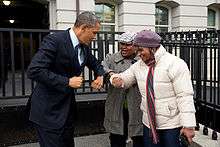Elbow bump

The elbow bump is an informal greeting where two people touch elbows. Interest in this greeting was renewed during the avian flu scare of 2006 and the 2009 swine flu outbreak, and the Ebola outbreak of 2014 when health officials supported its use to reduce the spread of germs.[1][2]
Kalaupapa Leprosy Settlement
An early popularization of the elbow bump began outside the Kalaupapa Leprosy Settlement in 1969 with the lifting of the quarantine policy, which forced leprosy patients to live in an isolated peninsula on Molokai. Many of the settlement's residents were devout Christians; when they began attending church services outside of the settlement, the members of the church congregation were fearful of making physical contact with them. Priests, too, were wary of such contact with the former Kalaupapa Settlement residents, but as a sign of good faith they would touch elbows. This greeting became popular among churchgoers of Hawaii in the early 1970s. Because leprosy is transmitted primarily through mucus, there is some evidence that the elbow bump constrained infections.
Urban youth
The elbow bump as a greeting is also attributed to be a derivative of the more well known fist bump, beginning in the 1980s. The earliest written record of the elbow bump by David Grimes[3] supports this hypothesis. More recently, Shaquille O'Neal demonstrated the derivative nature of the elbow bump in relation to the fist bump in 2004, when he dismissed Kobe Bryant's greeting with a half-hearted elbow bump.[4]
Popularity due to hygienic qualities
2006 Avian flu outbreak
A recent advocate of the fist bump is the World Health Organization. In 2006, due to fears of a possible avian flu pandemic, the WHO proposed using the elbow bump as a means of "keeping other people's cooties at arms length."[1] Dr. Michael Bell has been a principal advocate for using the elbow bump, noting that it can also help constrain the spread of diseases such as Ebola, by modeling social behavior that limits physical contact.[1][5]
2009 Swine flu outbreak
The elbow bump got renewed interest when the 2009 swine flu outbreak in Mexico began growing into a worldwide pandemic. By 2009 the elbow bump had grown so large in popularity that people in Mexico had taken it upon themselves to utilize the elbow bump to reduce the spread of disease.[2] As in 2006, the elbow bump was supported by a number of health officials,[6] such as Dr. Sanjay Gupta, CNN's chief medical correspondent.[7]
2012/2013 Seasonal influenza epidemic

The Manhattan Soccer Club endorsed the elbow bump as the safe alternative to the hygienically promiscuous traditions of vigorous hand-to-hand contact. This contact has been characterized, in the less dangerous formats, as handshakes and high-fives, but could also extend to orgies of perspiration and mucus slathered hands rubbing violently in the post-game "hand slap" line-up. The potential for mass contamination via these practices is obvious.
- At this point the MSC Board and the coaching staff would recommend that players not shake/touch hands with opponents after the games. The safest thing to do is to touch elbows. The coach or manager can explain this to the other team prior to the game.[8]
Fall 2014 Ebola out break
In October 2014 an outbreak of the Ebola disease caused people to people to revive the Elbow bump interest in the greeting during the 2014 Ebola scare.
In culture
By 2009, the elbow bump was endorsed by university officials[9][10] and Nobel laureate Peter Agre. The American Association for the Advancement of Science joined the World Health Organization in endorsing the elbow bump. However, some of these endorsements were meant as much to elicit good humor as for purposes of good hygiene.[10][11]
The word "elbow bump" was considered for Word of the Year in 2009 by the New Oxford American Dictionary.[12]
At the open-air service of the Greenbelt festival of 2009, worshipers were encouraged to greet each other with the 'elbow bump of peace' instead of the more usual 'holy kiss' during the Christian rite of peace, because of concerns over swine flu.[13]
References
- 1 2 3 Donald G. McNeil Jr., "Elbows to the ready if outbreak emerges: Bird flu would rule out handshakes" International Herald Tribune: The Global Edition of the New York Times, February 12, 2006
- 1 2 Andrew Gumbel, "Swine flu forces border crossers to swap handshakes for elbow bumps" The Guardian, Manchester, England, April 30, 2009
- ↑ David Grimes, "Goodbye, comrade; yo, dude" The Globe and Mail, September 20, 1991.
- ↑ Charles Elmore, "After big buildup, ABC delivers winning show," The Palm Beach Post, December 26, 2004
- ↑ Donald G. McNeil Jr., "Greetings Kill: Primer for a Pandemic", The New York Times, February 12, 2006
- ↑ Alfonso A. Castillo, "Swine flu virus puts handshakes on hiatus" Lubbock Online, May 3, 2009.
- ↑ Grace Wong, "Flu virus sparks 'social distancing' trend", CNN Health, May 1, 2009.
- ↑ Cameron Smith, "New York youth soccer club bans high fives and handshakes amid growing flu scare", Yahoo! Sports, Jan 15, 2013.
- ↑ Dean Robert Dolan of University of Michigan Ross School of Business and Vice Provost Earl "Gip" Seaver
- 1 2 Judi S. Cohen, "Swine flu fears: Handshakes noticeably absent from many college graduations: Some colleges suggest elbow bumps, air high-fives", Chicago Tribune, May 5, 2009
- ↑ Andrew Noyes, "Friday Funny: Anti-Swine Flu Handshake", National Journal, May 1, 2009.
- ↑ Jennifer Bogo, 'Carbon Neutral' edges 'Elbow Bump' for Word of the Year, Popular Mechanics, December 5, 2007
- ↑ Rev Simon Taylor "Greenbelt 2009 report", Simon says..., 1 September 2009